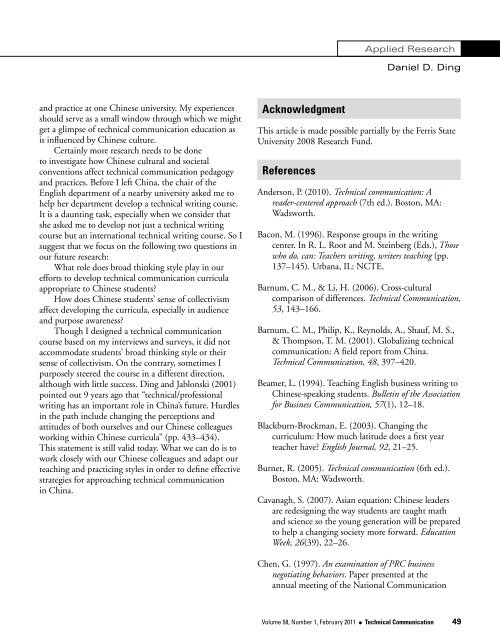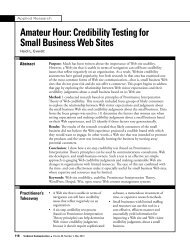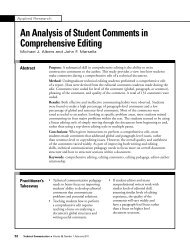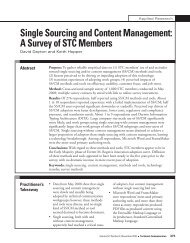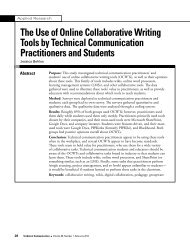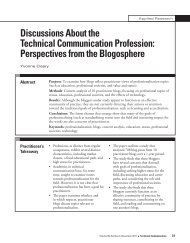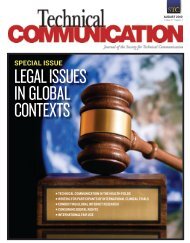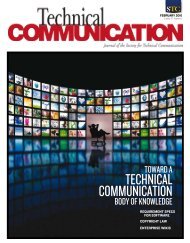When Traditional Chinese Culture Meets a Technical ...
When Traditional Chinese Culture Meets a Technical ...
When Traditional Chinese Culture Meets a Technical ...
You also want an ePaper? Increase the reach of your titles
YUMPU automatically turns print PDFs into web optimized ePapers that Google loves.
Applied ResearchDaniel D. Dingand practice at one <strong>Chinese</strong> university. My experiencesshould serve as a small window through which we mightget a glimpse of technical communication education asis influenced by <strong>Chinese</strong> culture.Certainly more research needs to be doneto investigate how <strong>Chinese</strong> cultural and societalconventions affect technical communication pedagogyand practices. Before I left China, the chair of theEnglish department of a nearby university asked me tohelp her department develop a technical writing course.It is a daunting task, especially when we consider thatshe asked me to develop not just a technical writingcourse but an international technical writing course. So Isuggest that we focus on the following two questions inour future research:What role does broad thinking style play in ourefforts to develop technical communication curriculaappropriate to <strong>Chinese</strong> students?How does <strong>Chinese</strong> students’ sense of collectivismaffect developing the curricula, especially in audienceand purpose awareness?Though I designed a technical communicationcourse based on my interviews and surveys, it did notaccommodate students’ broad thinking style or theirsense of collectivism. On the contrary, sometimes Ipurposely steered the course in a different direction,although with little success. Ding and Jablonski (2001)pointed out 9 years ago that “technical/professionalwriting has an important role in China’s future. Hurdlesin the path include changing the perceptions andattitudes of both ourselves and our <strong>Chinese</strong> colleaguesworking within <strong>Chinese</strong> curricula” (pp. 433–434).This statement is still valid today. What we can do is towork closely with our <strong>Chinese</strong> colleagues and adapt ourteaching and practicing styles in order to define effectivestrategies for approaching technical communicationin China.AcknowledgmentThis article is made possible partially by the Ferris StateUniversity 2008 Research Fund.ReferencesAnderson, P. (2010). <strong>Technical</strong> communication: Areader-centered approach (7th ed.). Boston, MA:Wadsworth.Bacon, M. (1996). Response groups in the writingcenter. In R. L. Root and M. Steinberg (Eds.), Thosewho do, can: Teachers writing, writers teaching (pp.137–145). Urbana, IL: NCTE.Barnum, C. M., & Li, H. (2006). Cross-culturalcomparison of differences. <strong>Technical</strong> Communication,53, 143–166.Barnum, C. M., Philip, K., Reynolds, A., Shauf, M. S.,& Thompson, T. M. (2001). Globalizing technicalcommunication: A field report from China.<strong>Technical</strong> Communication, 48, 397–420.Beamer, L. (1994). Teaching English business writing to<strong>Chinese</strong>-speaking students. Bulletin of the Associationfor Business Communication, 57(1), 12–18.Blackburn-Brockman, E. (2003). Changing thecurriculum: How much latitude does a first yearteacher have? English Journal, 92, 21–25.Burnet, R. (2005). <strong>Technical</strong> communication (6th ed.).Boston, MA: Wadsworth.Cavanagh, S. (2007). Asian equation: <strong>Chinese</strong> leadersare redesigning the way students are taught mathand science so the young generation will be preparedto help a changing society more forward. EducationWeek, 26(39), 22–26.Chen, G. (1997). An examination of PRC businessnegotiating behaviors. Paper presented at theannual meeting of the National CommunicationVolume 58, Number 1, February 2011 l <strong>Technical</strong> Communication 49


